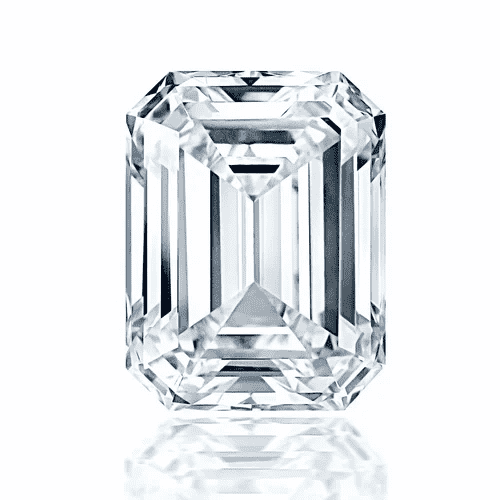An emerald diamond is a type of diamond cut that is rectangular in shape with cut corners.
Table of Contents
emerald diamond cut is also referred to as a step cut because of the long, flat facets that resemble steps. The emerald cut is known for its elegance, simplicity, and understated beauty, and it is a popular choice for engagement rings and other fine jewelry.
The emerald cut is characterized by its large, open table (the flat top facet), which allows for a clear view of the diamond’s interior. This cut also has fewer facets than other diamond cuts, which means that it may show fewer reflections and less sparkle, but it is prized for its clean lines and sophisticated look.
When shopping for an emerald shape diamond, it’s important to consider the 4 Cs of diamond quality: carat weight, cut, color, and clarity. The cut of an emerald shape diamond is especially important, as it can greatly affect the diamond’s appearance and overall value. A well-cut emerald shape diamond will have even facets, good symmetry, and a pleasing overall shape, while a poorly cut diamond may have uneven facets, asymmetry, or a less attractive shape.

- Origin: The emerald cut dates back to the 16th century when it was first used for cutting emeralds, hence its name. It wasn’t until the 20th century that diamond cutters began to use this cut for diamonds.
- Facets: An emerald shape diamond typically has 58 facets, but the exact number can vary depending on the individual stone and the cutter’s preference. The facets are arranged in a step pattern, with three rows of long, narrow facets on the crown (top) and three rows of similar facets on the pavilion (bottom).
- Length-to-width ratio: The length-to-width ratio is an important factor to consider when choosing an emerald shape diamond. A ratio of around 1.5-1.75 is considered ideal for most people, as it creates a balanced, elongated shape that is flattering on the finger.
- Clarity: The large open table and fewer facets of an emerald shape diamond can make inclusions (internal flaws) more visible, so it’s important to choose a stone with good clarity. A clarity grade of VS2 or higher is generally recommended, but it’s always best to view the diamond in person to assess its appearance.
- Color: Because of its fewer facets, an emerald shape diamond can also highlight any tint or color in the stone. It’s generally recommended to choose a diamond with a color grade of at least G, especially if the stone will be set in white gold or platinum.
- Settings: The emerald shape diamond is versatile and can be set in a variety of styles, including solitaire, halo, and three-stone settings. Because of its elongated shape, it can also be set horizontally (east-west) for a unique look.
- Maintenance: Like all diamonds, an emerald shape diamond requires regular cleaning and maintenance to keep it looking its best. Avoid exposing the diamond to harsh chemicals or extreme temperatures, and have it cleaned and inspected by a professional jeweler every six months to a year.
Here are some key features of emerald-cut diamonds:
- Rectangular Shape: Emerald-cut diamonds are typically rectangular, with length-to-width ratios ranging from about 1.3 to 1.7. However, square emerald-cut diamonds (with a ratio of 1.0) are also available.
- Step-Cut Facets: The emerald cut features long, narrow facets that resemble steps. These facets are parallel to the diamond’s girdle and create a hall-of-mirrors effect, giving the diamond a unique and sophisticated appearance.
- Cut Corners: Emerald-cut diamonds have trimmed or cut corners, which help prevent chipping and add to the diamond’s durability.
- Clarity Emphasis: This cut’s broad, flat planes showcase the diamond’s clarity, making any inclusions or flaws more visible. Therefore, it’s essential to choose a diamond with good clarity when opting for an emerald cut.
- Versatility: Emerald-cut diamonds can complement a variety of settings, including solitaire, three-stone, halo, and vintage designs. They are a popular choice for engagement rings but are also used in other types of jewelry, such as earrings and pendants.
if you wish know more about emeral cut diamonds please visit gia gem lab article about emeral diamonds
buy natural diamonds as well as lab grown diamonds at manufacturers price visit our shop page now.



